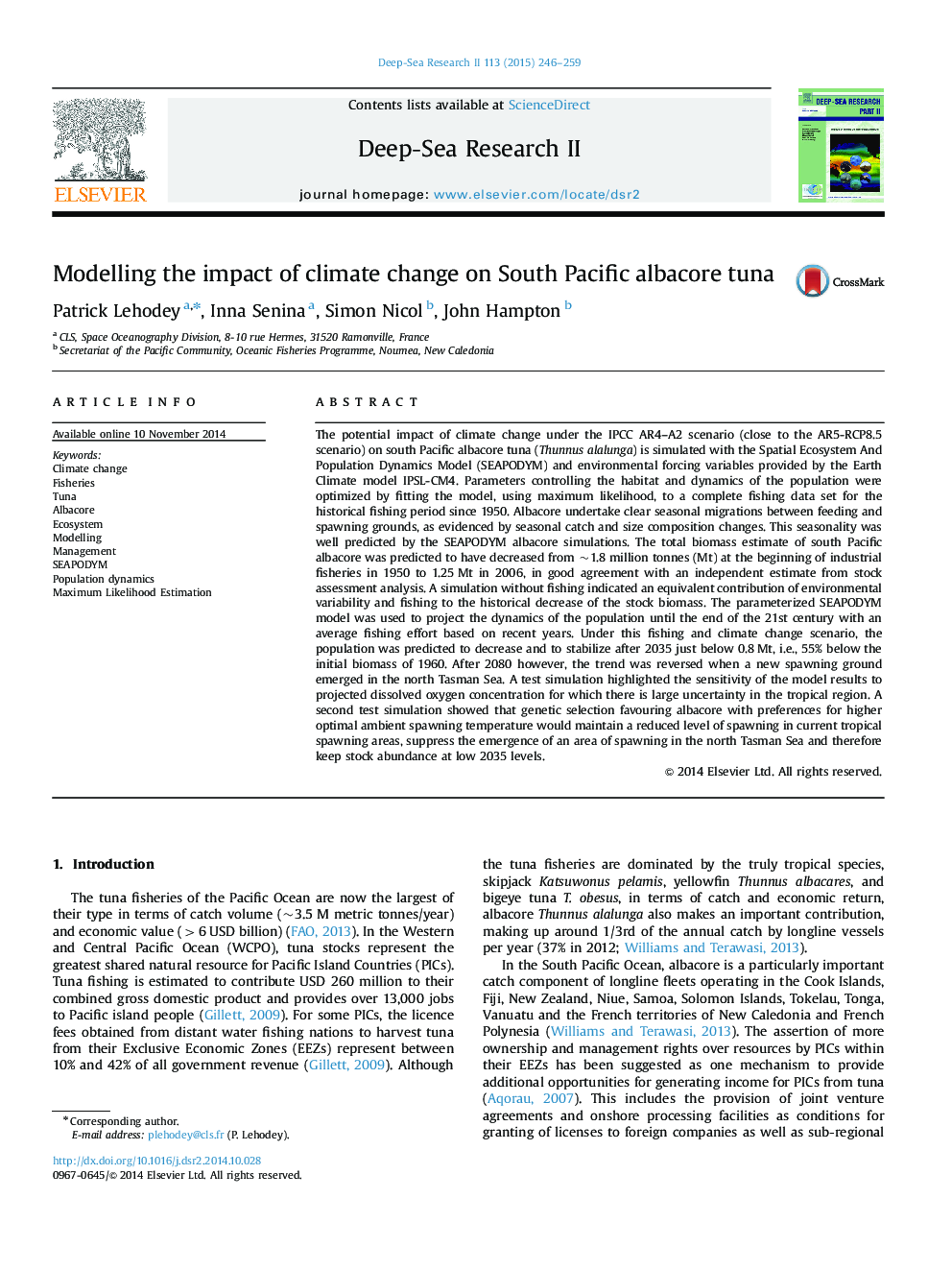| کد مقاله | کد نشریه | سال انتشار | مقاله انگلیسی | نسخه تمام متن |
|---|---|---|---|---|
| 6384138 | 1626427 | 2015 | 14 صفحه PDF | دانلود رایگان |
عنوان انگلیسی مقاله ISI
Modelling the impact of climate change on South Pacific albacore tuna
ترجمه فارسی عنوان
مدل سازی تاثیر تغییرات اقلیمی در جنوب باختری جنوب غربی
دانلود مقاله + سفارش ترجمه
دانلود مقاله ISI انگلیسی
رایگان برای ایرانیان
کلمات کلیدی
تغییر آب و هوا، شیلات، ماهی تن، گوجه فرنگی، زیست بوم، مدل سازی، مدیریت، سپتامبر، دینامیک جمعیت، حداکثر برآورد احتمالات،
موضوعات مرتبط
مهندسی و علوم پایه
علوم زمین و سیارات
زمین شناسی
چکیده انگلیسی
The potential impact of climate change under the IPCC AR4-A2 scenario (close to the AR5-RCP8.5 scenario) on south Pacific albacore tuna (Thunnus alalunga) is simulated with the Spatial Ecosystem And Population Dynamics Model (SEAPODYM) and environmental forcing variables provided by the Earth Climate model IPSL-CM4. Parameters controlling the habitat and dynamics of the population were optimized by fitting the model, using maximum likelihood, to a complete fishing data set for the historical fishing period since 1950. Albacore undertake clear seasonal migrations between feeding and spawning grounds, as evidenced by seasonal catch and size composition changes. This seasonality was well predicted by the SEAPODYM albacore simulations. The total biomass estimate of south Pacific albacore was predicted to have decreased from ~1.8 million tonnes (Mt) at the beginning of industrial fisheries in 1950 to 1.25Â Mt in 2006, in good agreement with an independent estimate from stock assessment analysis. A simulation without fishing indicated an equivalent contribution of environmental variability and fishing to the historical decrease of the stock biomass. The parameterized SEAPODYM model was used to project the dynamics of the population until the end of the 21st century with an average fishing effort based on recent years. Under this fishing and climate change scenario, the population was predicted to decrease and to stabilize after 2035 just below 0.8Â Mt, i.e., 55% below the initial biomass of 1960. After 2080 however, the trend was reversed when a new spawning ground emerged in the north Tasman Sea. A test simulation highlighted the sensitivity of the model results to projected dissolved oxygen concentration for which there is large uncertainty in the tropical region. A second test simulation showed that genetic selection favouring albacore with preferences for higher optimal ambient spawning temperature would maintain a reduced level of spawning in current tropical spawning areas, suppress the emergence of an area of spawning in the north Tasman Sea and therefore keep stock abundance at low 2035 levels.
ناشر
Database: Elsevier - ScienceDirect (ساینس دایرکت)
Journal: Deep Sea Research Part II: Topical Studies in Oceanography - Volume 113, March 2015, Pages 246-259
Journal: Deep Sea Research Part II: Topical Studies in Oceanography - Volume 113, March 2015, Pages 246-259
نویسندگان
Patrick Lehodey, Inna Senina, Simon Nicol, John Hampton,
